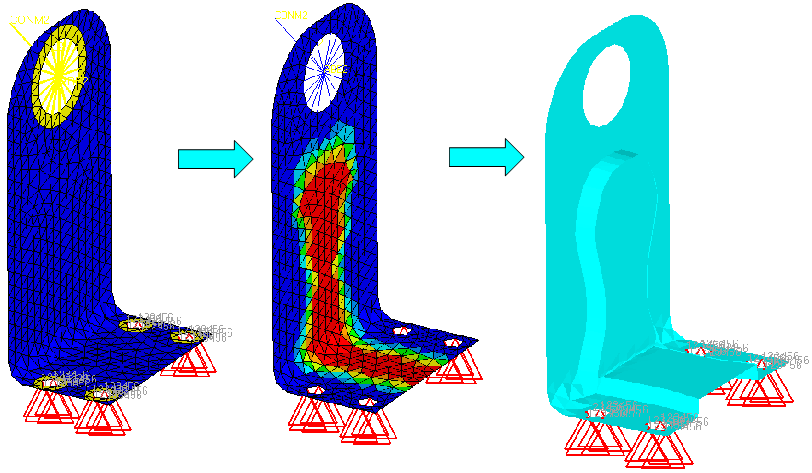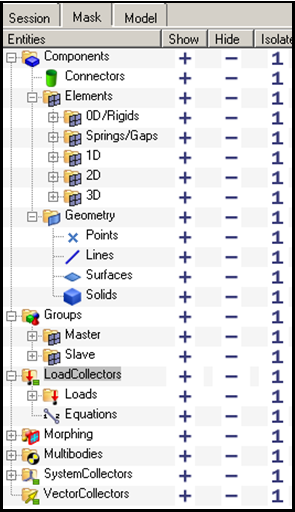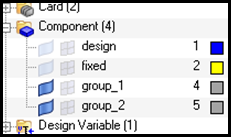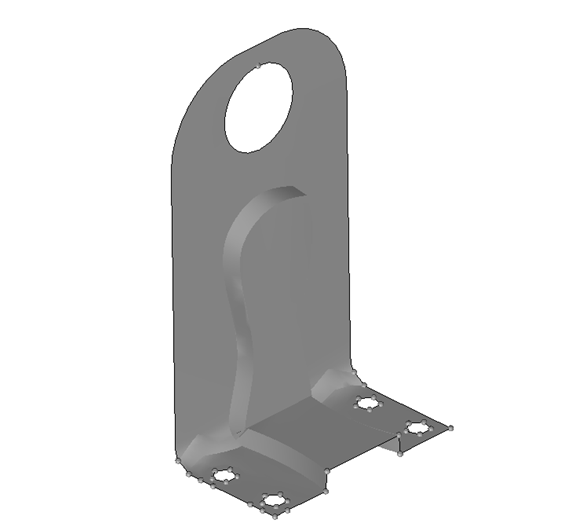OS-T: 3020 Automatic Recognization of Bead Results of an L-Bracket
In this tutorial you will run the completed model from OS-T: 3010 Topography Optimization of an L-bracket, post-process the results, and use the autobead functionality.

Launch HyperMesh and Set the OptiStruct User Profile
-
Launch HyperMesh.
The User Profile dialog opens.
-
Select OptiStruct and click
OK.
This loads the user profile. It includes the appropriate template, macro menu, and import reader, paring down the functionality of HyperMesh to what is relevant for generating models for OptiStruct.
Import the Model
-
Click .
An Import tab is added to your tab menu.
- For the File type, select OptiStruct.
-
Select the Files icon
 .
A Select OptiStruct file browser opens.
.
A Select OptiStruct file browser opens. - Select the Lbkttopog_bead.fem file you saved to your working directory.
- Click Open.
- Click Import, then click Close to close the Import tab.
Run the Optimization
- From the Analysis page, click OptiStruct.
- Click save as.
-
In the Save As dialog, specify location to write the
OptiStruct model file and enter
Lbkttopog_bead for filename.
For OptiStruct input decks, .fem is the recommended extension.
-
Click Save.
The input file field displays the filename and location specified in the Save As dialog.
- Set the export options toggle to all.
- Set the run options toggle to optimization.
- Set the memory options toggle to memory default.
-
Click OptiStruct to run the optimization.
The following message appears in the window at the completion of the job:
OPTIMIZATION HAS CONVERGED. FEASIBLE DESIGN (ALL CONSTRAINTS SATISFIED).
OptiStruct also reports error messages if any exist. The file Lbkttopog_bead.out can be opened in a text editor to find details regarding any errors. This file is written to the same directory as the .fem file. - Click Close.
View the Results
Shape contour information is output from OptiStruct for all iterations. In addition, Eigenvector results are output for the first and last iteration by default. This section describes how to view those results in HyperView.
Review a Transient Animation of Shape Contour Changes
- From the OptiStruct panel, click HyperView.
-
Load the results session.
- From the menu bar, click .
- In the Open Session File dialog, navigate to your working directory and open the Lbkttopog_bead.mvw file.
-
On the Animation toolbar, set the animation mode to
 (Transient).
(Transient).
-
Click
 to start the animation.
The animation shows how the shape changes over the course of the optimization.
to start the animation.
The animation shows how the shape changes over the course of the optimization. -
To slow down the animation, move the animation controls slider under the
Current Frame Indicator and adjust the Max Frame Rate slider.
Figure 2. 
Review the Optimized Frequency Difference
-
In the top, right of the application, click
 to proceed to the next page.
to proceed to the next page.
-
On the Animation toolbar, set the animation mode to
 (Modal).
(Modal).
-
In the Results Browser, from the list of load cases, toggle
between Iteration 0 and Iteration 12.
Figure 3. 
The topography optimization yields an almost 100% increase in the frequency of the first mode by reviewing the Mode 1-F value in the Simulation list. -
Click
 to animate the model.
to animate the model.
Generate a New Model Based on a Topography Result
Apply Optimized Topography
- Go back to HyperMesh.
- Click return to exit the OptiStruct panel.
- From the Post page, click the apply results panel.
- Click simulation = and select DESIGN - ITER 12.
- Click data type = and select Shape Change.
- Select displacements.
- Set component selection to total disp.
- Click .
- In the mult = field, enter 1.0.
-
Click apply.
The final nodal positions are applied to the structure.Tip: Be careful with saving the model now, the HyperMesh database has changed. This model can be used for further analyses. Results can now be viewed on the final shape.
- Click reject to get back the original shape.
- Click return to go back to main menu.
Import Final Geometry using OSSmooth and Autobead
-
From the Post page, click the OSSmooth
panel.
Figure 4. 
- In the file: field, select the OptiStruct base input file from which to extract the final geometry.
-
In the output: field, select the IGES output
format of the final geometry.
- The default output format is STL. Other format options are: Mview, Nastran, IGES, and H3D.
- If you select IGES as the output format, select the output unit type. The default is mm (millimeters).
- Select load geom to load the new geometry into the current HyperMesh session.
- Select autobead, and enter 0.3 for the bead threshold.
- Leave the rest of the options at their default settings.
- Click OSSmooth.
-
Click Yes to overwrite.
The new geometry will be automatically loaded into the existing HyperMesh file, turn off the display of all the elements to view the new concept geometry.
OSSmooth can automatically create geometry based on the new mesh.
- Click to generate new geometry from the optimization results.
- Click Save and Exit to continue.
-
In the Mask Browser, click Isolate for
Geometry and click Hide for Load
Collectors.
Figure 5. 
-
In the Model Browser, uncheck geometry
display for the original components design and fixed.
Figure 6. 
